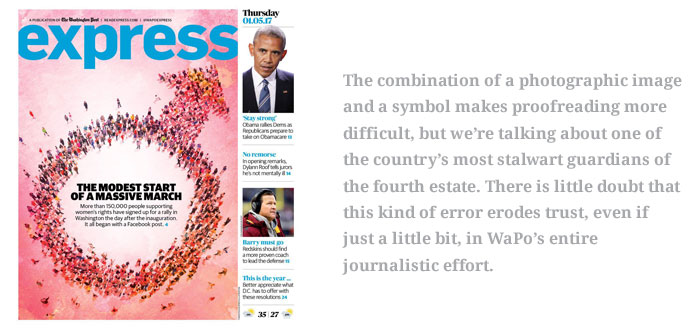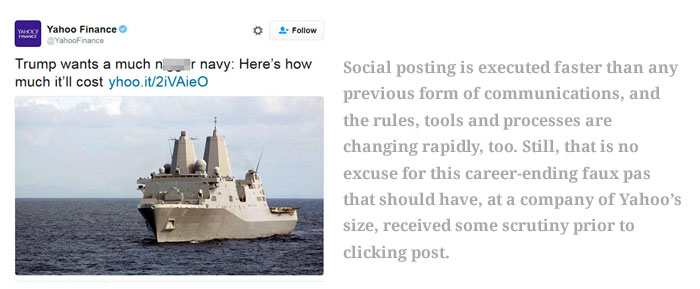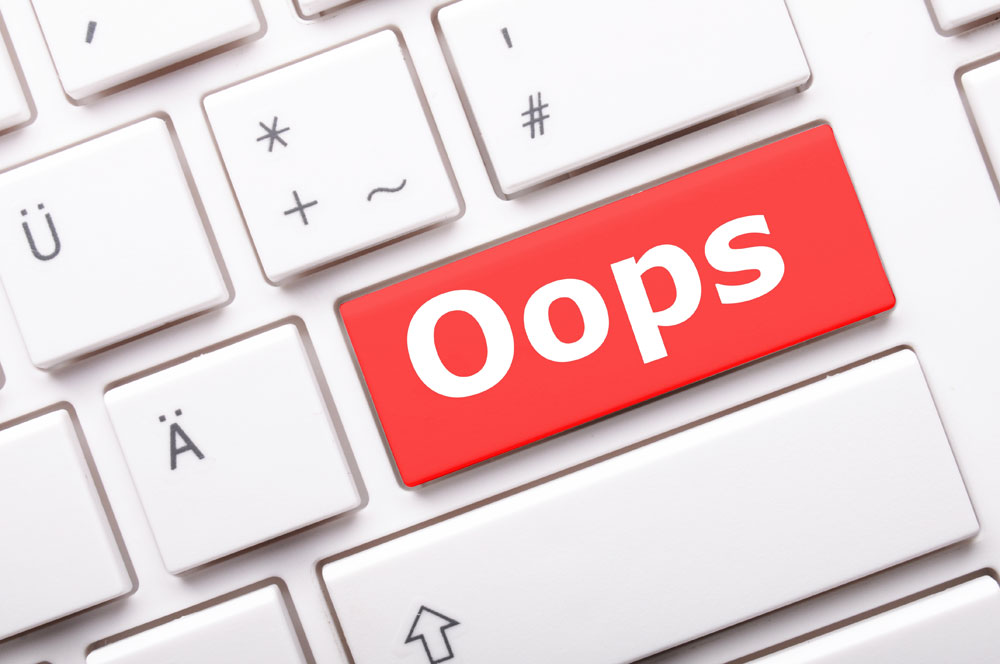Welcome to the age of inaccuracy
MISTAKES HAPPEN, BUT OOFAH!
Every communications professional makes mistakes. Errors are an unavoidable part of the communications process, and no matter how careful one is, from time to time a mistake will manifest itself when it’s too late to rectify…like a zit revealed as your prom date rings the doorbell.
Still, caring professionals employ masochistic efforts to maintain accuracy. Precautions from paid proofreaders to multiple approvals generally keep VFC error-free, but we need to preface this observational essay with the painful fact that we have made, and will make, mistakes. Recent absolutely cringe-worthy publishing faux pas sparked us to wonder how… How could mistakes of this gravity slip through to a final stage of publishing with professionals at the wheel?
We have our theories…
SO MUCH STATIC
Communication in 2017 becomes exponentially more voluminous and complex every day. The Internet has facilitated a static storm of words, opinions, noise and mostly meaningless chatter that will statistically yield more errors. Naturally, some of them will be more egregious than others.
Everyone is moving fast and doing more. That’s our excuse and it is likely the excuse of the two examples we are about to cite, but that excuse isn’t good enough for VFC’s infrequent and largely unnoticed errors and it shouldn’t be for the two FUBARs below either.
If you’re too busy, then you need to improve skills and processes. Period.
THE HISTORY OF COMMUNICATIONS, 1976 – 2017
Apple is so good. They made computing personal. It was mostly a marketing device because, although everyone can own a computer, not everyone can compute. Not everyone is a composer, an author, a programmer, a photographer, a writer, an artist… Still, somehow, everyone with a computer thinks that he or she is.
When computing first became personal, everyone was a desktop publisher, and this enraged communications professionals. Digital cameras became affordable and everyone became a photographer, enraging photographers. Web publishing got dumbed-down and everyone was a developer. Social networking became ubiquitous and everyone became a public relations pro and pundit. Not only were the pros enraged, but also devalued.
It’s a natural fact that amateurs are going to make more mistakes than trained, experienced professionals. Now, online debaters expect to be taken seriously while misspelling arguments because, after all, that’s not their message.
Is that the reason we’re seeing more mistakes, inaccuracies and misinformation?
Floods can ruin a house. Poor communications decisions can take down a business.
HERE COMES THE FLOOD
Communication clients can be like homeowners wanting to build in a flood plain. The general contractor can warn them of the dangers: after all, he has built a lot of houses and understands the devastation a flood can do. Floods can ruin a house. Poor communications decisions can take down a business.
But, there are floods of all sizes, and usually a client directive with which a creative is taking issue only results in some wet carpeting.
Is micromanaging and not letting the professionals run with a strategic plan causing an uptick in these giant gaffes?
ERRORS BECOME ACCEPTABLE
This past year, a very terrible reality—born from the alchemy of a pervasive Internet, everyone being a publisher, poor decisions and powerful influencers with suspect agendas—reared it ugly head: Fake News. So now we have influential forces publishing mistakes on purpose, and the mere fact that Fake News exists makes all other mistakes not really that bad in comparison.
Concurrently, content pipelines are gushing with political candidates speaking in flippant, error-riddled stream of consciousness to vast audiences. Corrections are ignored, and we all move on making it seem like accuracy really doesn’t matter that much. Politicians have always used language to bend facts to their benefit, but one candidate’s skill lies in powering past almost any criticism, kind of negating the importance of veracity.
Is the laissez-faire relationship between the truth and public figures to blame for everyone’s carelessness?
THE MISTAKES
Here are but two recent examples of public communications that may have been rushed, may not have been developed by professionals, may have had too much direction or maybe their creators just don’t care that much because tomorrow no one will remember them.
There may be some punitive recourse for an individual—an art director or a writer: maybe someone was even fired—but the brands won’t be scratched or, if they are, it will buff out in the noise of other error-filled information scratching at the door to be seen, heard and noticed.


Whatever the root causes are, there is no denying that something sinister has pervaded not only our communications but also our culture. Indeed, we are entering the age of inaccuracy.
It’s no longer humorous to see a misspelled sign: it’s commonplace. And, when you correct an online expert for using ‘your’ when he or she should have used ‘you’re’, you’re the one who is denigrated as a grammar cop. Those of us advocating for accuracy and truth have become the bad guys!
At any rate, legitimizing inaccuracy has reached a tipping point, and anti-intellectualism may have just become the preference in a society that had such promise…

